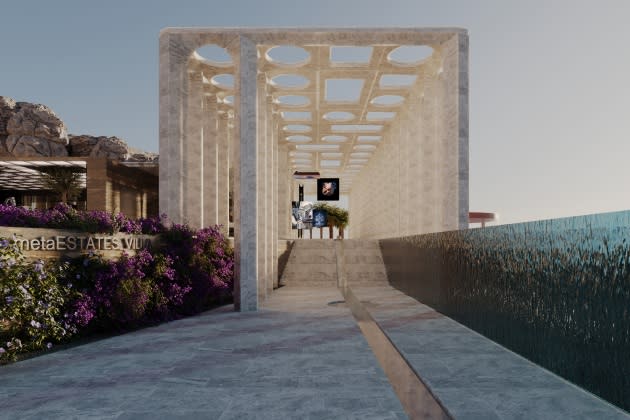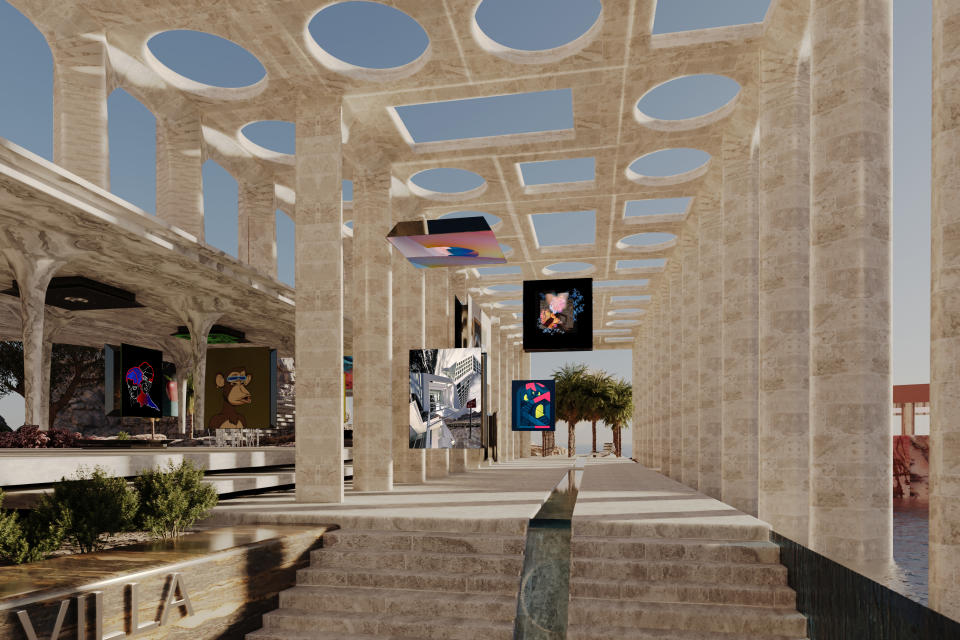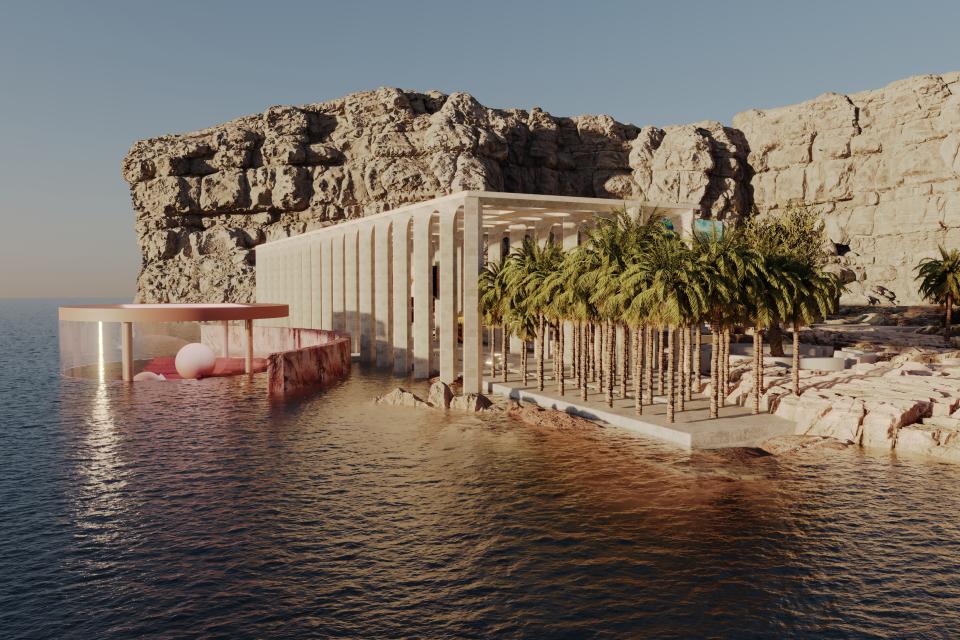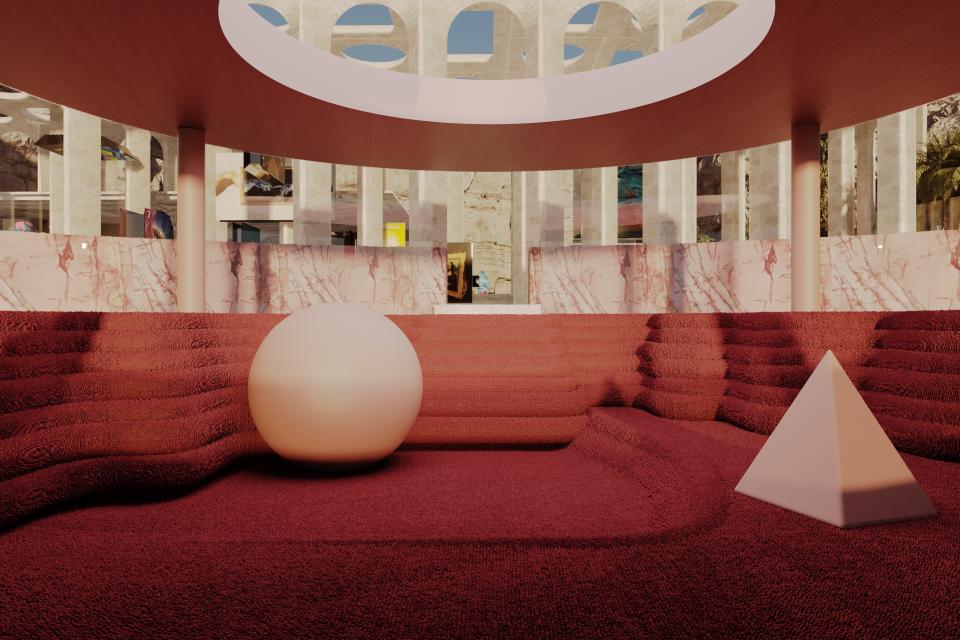Luis Fernandez’s Virtual NFT Villas Work Across Metaverses

It’s been four years or more since the fashion world clocked the work of architect-turned-menswear designer-turned-architect again Luis Fernandez. But it may be interested in his latest creation: a luxe waterfront virtual venue called MetaEstates_Villa, which just dropped publicly via NFT.
The villa boasts a rather unique feature: interoperability. Instead of being limited to one metaverse platform, owners get a choice of where to place their new property — be it Spatial, Decentraland, Cryptovoxels, Unreal Engine 5, Nvidia Omniverse or other environments, spanning 10 virtual platforms in total so far, with more to come.
More from WWD
This flexibility comes courtesy of MetaMundo, a virtual tech platform gaining attention for its “open metaverse” approach.
“We partnered up with MetaMundo and made that deployable-ready for all the different open-source metaverses. So if you have land in Decentraland, you can drop it in there. If you have land in Cryptovoxels [and etc.],” Fernandez explained to WWD. “And because all the metadata is refreshable, as new platforms come on board, we’ll start to update those as well.”
The approach aims to solve a fundamental issue with today’s metaverse: The virtual world is not a single place, but multiple ecosystems, most of which don’t work together. That may change one day — it would have to, in order to form the sort of seamless, connected wonderland that Meta’s Mark Zuckerberg envisions — but for now, the metaverse remains a disjointed patchwork of different platforms, graphics and technical specifications.
That’s a significant obstacle for brands, especially if they want to establish a universal, or at least consistent, virtual presence. They can build one digital storefront or headquarters for one environment, but they would have to build it over and over again to cover other gaming or metaverse environments. These platforms have different specs, file types and, in the case of real estate, land or plot sizes, so it’s not a one-size-fits-all situation.
The scenario looks like a complex, even daunting affair. MetaMundo cofounder Mark Studholme, a serial entrepreneur with a background in developing digital tools for architects, understood those technical challenges and decided to take them on. Over time, his team developed an “in-house conversion pipeline,” he told WWD.
Building 3D spaces, especially with beautiful settings and refined details, results in massive files and they can be tough to deal with. MetaMundo’s system takes those “seed” files and creates a more adaptable master file, which is capable of being retooled for a variety of metaverse platforms. The technical details on how it works run deep and involves an array of file types, including those used by top animation and gaming developers, like Pixar, Nvidia, Epic and others.

Courtesy image
Ultimately, it means MetaMundo’s platform can meet a broad range of specs — from the highest level of fidelity, as in award-winning animation and gaming, to lower fidelity environments such as Roblox and even augmented reality. In addition, the platform is constantly expanding compatibility to include more file types and metaverses.
In other words, current owners of its NFT environments, including Fernandez’s villas, will have more virtual worlds where they can put them over time.
“That’s the future-proofed version that you get in this NFT,” said Studholme, though he admits it doesn’t come without plenty of effort, including human intervention. “At the moment, I would say, it’s 60 percent automated and 40 percent [manual].” But MetaMundo is working toward fully automating it.
Last month, the company launched a 3D NFT marketplace offering metaverse scenes as well as assets for use across Decentraland, The Sandbox, Cryptovoxels and Spatial. The company targeted art galleries or public spaces, such as music venues and parks, but owners can use those scenes however they wish — that is, as long as they don’t violate the NFTs’ terms.
For MetaEstates_Villa, the owner can throw parties or hang out with up to 50 friends, or use it commercially as a showroom, for business meetings, event space and other purposes, up to a limit. Though the buyers own the NFTs, they don’t own the intellectual property. It’s similar to buying a music disc or MP3, but not actually owning the rights to the song itself.
That may not matter to buyers drawn in by their unique interoperability — or to owners who were simply charmed by the open aesthetic and design ethos.
Working with an architectural designer known simply as “The Line,” Fernandez fashioned a sophisticated space with beautiful views, towering columns and a swimming pool, which repeats the water theme of the surrounding ocean directly on the grounds. Imagine a heightened fantasy version of a Pacific coast getaway, with the clean lines and minimalism that Fernandez is known for offering a balance against the dramatic cliff side views.
Architecture fans may note a Frank Lloyd Wright sensibility to the landscape, or a Mies van der Rohe-like spirit in the interior’s use of natural stone. But it’s all filtered through Fernandez’s lens.

Courtesy image
A self-described “hybrid-creative,” the designer has racked up notable credibility in fashion as cofounder of Number:Lab, creative director of Craft Atlantic and CFDA member. But even before he dove into fashion — and one day could return, he hinted — he trained as an architect and had worked on high-profile retail projects.
“I first started designing retail stores as an architect. I did a lot of the Barneys stores back in the day,” he continued. Fernandez was the project architect for Barneys New York’s flagship stores in San Francisco and Las Vegas. “I think that that — coupled with my experience of building a brand, selling product, creating product — has informed a lot of my approach to designing metaverse spaces in the sense of, what are we doing in there? What’s the utility of it?”
The contemplation seems apparent in the villas, which took more than a year to come together. That’s a long time, but it wasn’t all spent on concepting and design. “This project has been 18 months in the making, and a big part of that was waiting for technology that allowed me to do something that was much more high fidelity and much more refined than what exists out there,” he said.
This amount of consideration — and time — is unusual, especially in comparison to the frenzied pace of digital property development. Buildings, campuses, even penthouses seem to be cranked out at amazing speed in what looked like a metaversal land grab. The real question, though, is if people are actually buying them.

Courtesy image
A recent study by research firm Technavio estimated that the virtual real estate market would grow by $5 billion by 2026. A McKinsey report predicted that four years later, in 2030, the market would balloon up to $5 trillion. But the bubble appeared to be bursting, with land prices plummeting a whopping 85 percent. That’s partly due to cryptocurrency’s volatility, which brings good, bad and often dire news, depending on the day.
The other part is demand. Is there any? There was, at least based on the string of high-profile, high-value land deals at the end of last year. In November, Tokens.com’s Metaverse Group picked up a 116-parcel estate, which equates to roughly 6,090 square feet, in Decentraland’s Fashion Street, hoping to lease virtual space to fashion brands. Then it came back to pick up more land, ponying up another $3.2 million. The same month, Republic Realm shattered the record with a $4.3 million sale in The Sandbox.
If the craze is abating, the effect on projects like MetaEstates_Villa is hard to predict. Fernandez’s latest NFT offering doesn’t actually include the sale of land, but it does require land ownership if purchasers want to enjoy the space. Otherwise, they’re just staring at a set of VOX, GLB and other Web 3.0-ready files.
So far, investors like Peter Martin, producer, VR director, futurist and the chief executive officer of metaverse developer “0,” aren’t deterred, buying one of the 100 NFT villas made available this week. At press time, a little over a quarter of them have sold for 0.5 ETH each (or $924.71, as of this writing).
Either way, projects like this highlight the need for interoperability across virtual worlds. MetaMundo and Fernandez may be early to this game, but such efforts are crucial if the metaverse is to become the next evolution of the internet, as promised by tech executives like Zuckerberg and many others. In the future metaverse of the Meta founder’s dreams, visitors can gather, enjoy experiences and bring along their digital clothes and collectibles wherever they go.
The Meta CEO should be paying keen attention to this type of work. He’s been betting big — perhaps betting everything — on what, so far, seemed like a pretty nebulous promise.
Now, however, it all seems a little more plausible.
Sign up for WWD's Newsletter. For the latest news, follow us on Twitter, Facebook, and Instagram.

 Yahoo Movies
Yahoo Movies 
